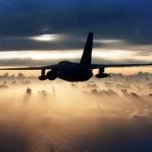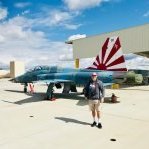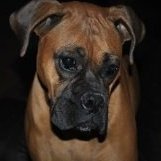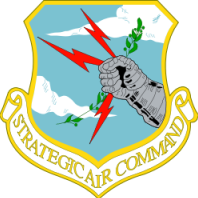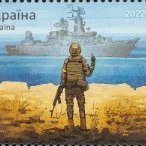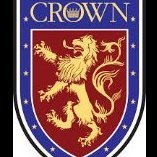-
Content Count
807 -
Joined
-
Last visited
About Vidar_710
-
Rank
Step away from the computer!

- Birthday 06/01/1964
Profile Information
-
Gender
Male
-
Location
Jacksonville, Fla
-
Interests
Aviation and Modeling
Recent Profile Visitors
8,206 profile views
-
Wheels are on! Despite the big hunk-o-resin of a cockpit tub, it wasn't enough to counter the resin tail and afterburner/tail feather parts. She was a tail sitter! 3 fishing line casting weights were cut in half and flattened. Just enough to sit nicely hidden under the ejection seat without affecting its proper height in the tub.
-
Around of pastel work on the top. Stepping away from it for the night to see if I like it in the morning.
-
Starting the oils work First the white is blended into place... Then the black is positioned... Then everything is blended together Same done to the top... First of the pastel work going in on the bottom... More to come. Tracy
-
Decals finished with a protective clear coat. One of very few images of a test bed aircraft's staining on the belly. Mine will be more assertive representing a "What If" production aircraft in service. First layer of Yellow Ochre oil representing aged oil and hydraulic staining in the skin. Additional oil layers of Brown and black with some white to tone things down. Dark washes added to the skin and panel lines. After the excess wash is removed, the dull coat with be applied to protect it. Additional weathering will be ad
-
Hardpoints created by the manufacturer were terribly out of place. They clustered them so close; the bombs would not hang properly and would be bumping into each other. Here, the hardpoints have been filled in with Epoxy dough and feathered in with a wet finger. Bomb Hardpoints and AIM-7 Sparrow fin slots filled in since I'll be arming with AIM-120 AMRAAM's. Graphic showing actual hard point positions that distribute throughout the wing surface instead of clustered tightly at the outer 3rd of the wing. Template being made with parchment pap
-
Paint. decaling, and washes complete... All that's left is to add fins to the missiles, sway brackets, and paint the bright aluminum binding straps on the GBU's and they'll be done.
-
GBU's are from VideoAviation dot com Tracy
-
Stepping away from the jet for a bit to do the tedious stuff. Shifting to weapons work. Layering in the colors. Resin GBU 54's and 3D printed AIM-120C AMRAM's and AIM-9X's... Plus the metal landing gear... Primers Yellow stripe that peaks through the GPS head gear pre-shading and marbling Olive drab on and masked to spray the Lt Ghost Gray fin groups and GPS gear. Still a lot of work left... Missile fin (not shown have been sprayed a mix of stainless steel and Jet exhaust.
-
Peeled it off the shelf after more than a year. Made some strides. Taping the cockpit up really put a block on me with this project for some reason. When I finally made myself do it, things moved along pretty well. Cockpit masking stigma finally overcome... Primer. I used Stynylrez. NEVER AGAIN! That sh!t sux! Paint comes off in sheets down to bare plastic with masking tape use. First layer of pre-shading with PINK. Then BLUE The white highlighted panel lines The Black streaking f
-
Well, took a little time to get the rest of it into primer... Thoroughly happy that there's no ghost seems or gluing sink marks anywhere to be found.
-
I've delayed this long enough... I managed it on the very first try. 😉 Cutting the top deck of the secondary hull out of clear acrylic. Here the pilot holes for the warp pylon assembly with its wiring opening have been pre-cut. The three holes for the styrene tubing that run through the dorsal assembly have been drilled through at the correct angle which will properly align the neck onto the secondary hull during assembly. The excess acrylic was cut from a safe distance with a jig saw and acrylic cutting blade to reduce the chance of mistakes and/or accidents. The openin
-
Is anyone still seeing Photo Bucket Watermarks on some of these images? Thanks, Tracy
-
A completely new rebuild of the dorsal/neck section was needed. I was not happy with how the spacer plates did nit align, particularly at the rear corners where they are most noticed. I came up with a more restrictive 3-tube jig to ensure everything aligned during the stacking of the plates. Here all the cut plates are stacked on the new jig. The center section is where the torp launcher recesses are as depicted by the penciled markings. All three sections loosely stacked on the jig. All the plates finally cemented together.
-
I have finished the rebuild of the dorsal assembly and have a series of photos of the In-work progress, but for some reason, I cannot upload photos to my Photobucket account. A query is in to Support, and I hope to have it resolved soon.
-
Sorry for being away. Lots of work, then my entire household went down with viral bronchitis/pneumonia. Just now getting over it after almost a month! If you go back to pages 2 and 3, I've been working on a complete re-build of the neck/dorsal assembly. While it looked "OK" from a distance and at the right angle, I have never been happy with how the spacers aligned between the larger plates. They look like bad dental work. In addition, I failed to get the proper 30 deg angle to the assembly. I've remedied that and will be posting my progress soon. Regards,



